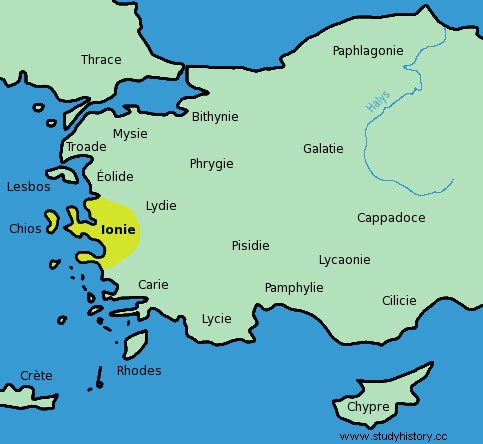Ionia

Ionia is a region located west of Asia Minor, between Phocaea and Miletus.
In Antiquity, it federated twelve Greek cities, from the mainland and the islands:Chios, Ephesus, Eritrea, Clazomenes, Colophon, Lebedos, Miletus, Myonte, Phocaea, Priene, Samos and Teos. Halicarnassus joined them afterwards. Brilliant center of Hellenic civilization in the 7th and 6th centuries BC. AD, it belongs to a larger group called Asian Greece or Eastern Greece.
Its settlement from the second wave of Achaean migration, in the 11th century BC. J.-C., had integrated, following numerous mixed marriages, Dorians and pre-Hellenic populations. This population was united by a common dialect, and a common religious sanctuary, the Panionion located in the territory of Priene.
Each city was independent and had its own government and its own social organization, but they had the same political evolution, towards tyranny, as the other Greek cities, with which they were united by a community of culture, even if there was many border conflicts.
The Ionian coasts presented many economic advantages:good natural shelters facilitating the establishment of ports for trade with easy communications towards the hinterland, a pleasant climate, open valleys for the cultivation of cereals and livestock horses, plateaus for raising sheep, hills for fruit trees and olive trees.
Ionia is the first region of Greece where philosophy, art (especially architecture with the Ionic order) and science developed, benefiting from the intellectual wealth of the Near East and Egypt. The Ionian cities produced many great pre-Socratic thinkers, great artists and great architects, such as Thales of Miletus, Anaximander, Anaximenes, Leucippus, in Priene, Heraclitus in Ephesus, Anaxagoras in Clazomenes and Pythagoras in the island of Samos.
Ionia was coveted for its economic wealth and intellectual development by powerful, ambitious and enterprising neighbors. The Ionians had developed luxury and quality products, banquets and elegant and cultured courtesans fascinated. They were representative of the very high point of sophistication reached by Greek civilization. However, the Ionians were bad fighters, poorly trained, their cities were often divided, their roads were easy for trade and exchange, but also for invasions.
Ionia passed first under the protectorate of the Lydians, then after the victory of Cyrus over Croesus, under the domination of the Persians, to whom it had to pay heavy tributes and maintain the garrisons, in return for a certain autonomy and the freedom left to local bullies.
This situation worsened with the king of Persia Darius I and ended in 499 BC. to a revolt in Ionia, favored by the military reverses of the Persians in the Danubian steppe, and the military support of Athens and Eretria. But the revolt turned into disaster despite some victories, and the population paid heavily for this episode:destruction and burning of Ephesus and Miletus, deportation of populations as slaves in Mesopotamia in 494 BC. J.-C., until their total allegiance.
Many inhabitants (merchants, artisans, poets, thinkers) emigrated, taking with them the refinements of their culture. It was a setback to the intellectual development of Ionia.
It was only after the victories of the cities of mainland Greece at Marathon, then at the Battle of Salamis, in -480, at the Battle of Plataea, and at the Battle of Cape Mycale in -479, that the Ionians recovered their freedom, the westward expansion of the Persian Empire was definitely halted.
Athens, which had played a leading role in the victory, drew glory and profit from it, and in 478 BC. J.-C., by the creation of the League of Délos, it undertook to constitute around it a maritime empire ensuring its hegemony on the Aegean Sea, from now on prohibited with the Persian vessels, and its domination on the Greek world. The war ended in 449 BC. J.-C. and the defeat of the Persians was confirmed by the peace of Callias.
